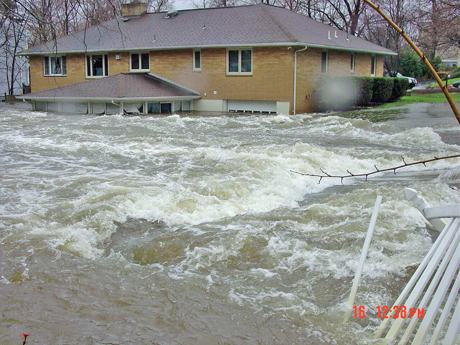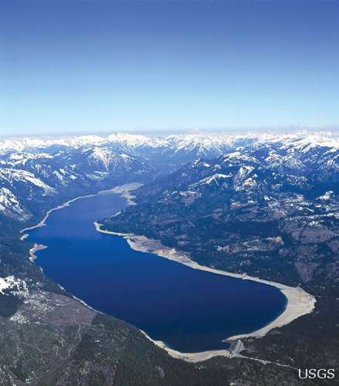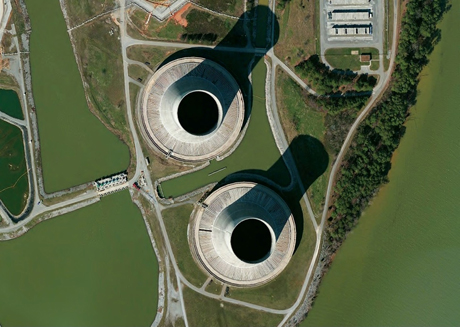
USGS Feature - Earth Week - A Tribut(ary) to Water
Water is key to life on Earth. While the United States and over 190 other countries across the world celebrate Earth Day, the U.S. Geological Survey, the premier Earth science agency and leading water research institution in the federal government, will be celebrating “Earth Week” with a special tribute to water science.
The USGS is the world’s largest provider of water data. Within the agency, about a third of all USGS employees focus their work on water resources, serving as a reliable source of water data that is used by other federal agencies, state and local governments, non-government organizations, scientists, industry, outdoors enthusiasts, and many others around the world.
Each day, USGS continues to report on water availability statistics, water’s role in climate change, the connection between water and energy, the relation between water quality and human health, and water-related natural hazards such as droughts, floods, and landslides.

Photograph looking downstream from the bridge at the gaging station on the
Hackensack River at Rivervale, New jersey (USGS downstream order number 01377000),
a few hours after the flood peak on April 16, 2007, at a stage approximately 0.3 ft less than the peak.
Clean, plentiful, and affordable water for future generations
USGS science can help water resource managers better protect the Earth’s fresh water supply and cultivate an understanding of water availability.
To understand water availability, it is necessary to accurately report where water is located and how the water is being used. The National Water Census is a USGS initiative aiming to create a national picture of water availability and use.
A secure water future relies on USGS science
Water plays a crucial role in the dynamics of the Earth system and a changing climate can affect the quality and quantity of water. Water availability on land regulates fluxes of water and energy into the atmosphere, thereby playing a major role in the control of Earth’s climate. Atmospheric and ocean temperatures are rising as a result of increased greenhouse gases in the atmosphere. The effect of climate change on water availability is poorly understood, but USGS scientists are working to improve this understanding and to provide water managers with information needed to adapt to a changing climate.
Rises in global temperature can cause glacial melt to increase, which could significantly decrease freshwater resources. Another effect of melting glaciers and ices sheets is sea level rise, which can damage many coastal ecosystems.

Climate change projections indicate a steady increase in temperature progressing through
the 21st century, generally resulting in snowpack reductions, changes to the timing of snowmelt,
altered streamflows, and reductions in soil moisture, all of which could affect water
management, agriculture, recreation, hazard mitigation, and ecosystems across the nation.
A secure energy future is fueled by USGS water science
Water and energy have a close relationship where almost all energy development ventures require water for a variety of purposes.
USGS scientists study the consumptive use of thermoelectric power. Water for use by thermoelectric power plants constitutes the single largest category of water withdrawals, but much of that water is not consumed, but returned to the environment.
Produced waters are those volumes of water that are typically recovered during oil and gas exploration, development or production. USGS examines the chemical composition, uses and environmental effects of these produced waters.
Water for a safe and healthy tomorrow starts with USGS science today
Human health is dependent on the quality of water used to drink and produce food. When water quality is threatened by toxins and other contaminants, humans may become more susceptible to disease, and could be threatened by an unhealthy food source.
The majority of the human body is made up of water, and scientists have determined that about 79 percent of the body of a newborn is made up of water. Constant replenishment of healthy water is key to a healthy life.
There are several USGS programs studying water quality including the Office of Water Quality and the National Water Quality Assessment (NAWQA) Program.
Tracking floods is not just a job at USGS – it’s a matter of public safety
As valuable as water is to human health, it can potentially be very hazardous as well. Floods can be detrimental to communities, infrastructure, and agriculture.
USGS flood information helps to inform managers about flood risk and helps to formulate thorough assessments of flood risk in particular areas. Flood risk is noticeable in everyday life, potentially affecting the economy. The National Flood Insurance Program utilizes USGS science to help establish flood insurance rates throughout the Nation.
Through the WaterWatch program, the USGS is able to monitor water levels and flood activity across the nation. Anyone can monitor water levels and streamflows through the USGS WaterAlert program, which allows users to receive a text message or email about specific rivers and streams when water reaches a certain level. Tracking potential floods is a key to monitoring the safety of people, their homes, and our communities.
The Legacy – Science for a Changing World
The history of the USGS is both exciting and flowing with information. The bureau continues to expand its reach throughout all of the earth science disciplines.
“The USGS has a strong 135-year legacy of providing reliable and relevant scientific information to decision-makers,” said Suzette Kimball, Acting USGS Director. “The President’s proposed budget for Fiscal Year 2015 recognizes the USGS is uniquely positioned to support our Nation’s needs through multi-disciplinary earth science research. This is crucial for understanding our land, its resources, and our changing climate.”
In honor of helping to sustain the planet explore USGS science not just on Earth Day, but every day.

Natural-draft cooling towers and one of two intake screens and associated pumps for the
Tennessee Valley Authority, Sequoyah Nuclear Power Plant, Tennessee. Natural-draft tower airflow
is drawn through the packing or fill (distributed at the base) by means of the small density difference
between the warm moist air inside the tower and the cooler ambient air outside the tower (Stultz and Kitto, 1992). Because of the small temperature and density difference, these cooling towers tend to be tall. These towers are relatively open cylindrical structures. Modern units are sometimes referred to as hyperbolic towers because of their shape. The heat rejected from the steam to the cooling water is circulated through the
cooling tower where the heat is rejected to the atmosphere as latent and sensible heat.
For further information, please click http://www.usgs.gov
TOP
|